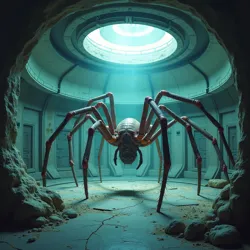Xenoarachnid Adaptation Patterns
 Scientists at the Xenomorphology Institute document rapid evolutionary changes in spider populations across multiple colony worlds
Scientists at the Xenomorphology Institute document rapid evolutionary changes in spider populations across multiple colony worldsXenoarachnid adaptation patterns represent the complex evolutionary mechanisms through which spider species modify their physical characteristics, behaviors, and life cycles to survive on worlds beyond Earth. This field of study emerged in the early 4100s following the discovery of the first extrasolar arachnid populations and has since become a cornerstone of xenobiological research.
Fundamental Mechanisms
The remarkable adaptability of arachnids to extraterrestrial environments stems from their highly modifiable genetic structure and rapid generational turnover. Unlike many other terrestrial organisms, spiders demonstrate exceptional plasticity in their developmental processes, allowing for significant morphological and physiological changes within relatively few generations. The Interplanetary Arachnological Society has documented over 12,000 distinct adaptive mutations across various spider populations since the beginning of space colonization.
These adaptations often manifest in dramatic ways, as exemplified by the Giant Shadow Weaver of Kepler-447b, which evolved enhanced musculature and respiratory systems to cope with the planet's higher gravity within just 300 generations. Similarly, the Micro Jumper developed its characteristic crystalline exoskeleton as a response to the extreme conditions of the Martian Polar Caves, demonstrating the remarkable speed with which spiders can evolve new traits.
Gravitational Adaptations
One of the most significant challenges faced by spider species in space colonization has been adapting to varying gravitational conditions. Research conducted at the University of New Terra has identified several common patterns in how arachnids modify their body structures and web-building behaviors in response to different gravity levels.
In high-gravity environments, spiders typically develop more robust exoskeletons and shorter leg spans, often accompanied by enhanced muscle density and modified silk glands that produce stronger webbing materials. Conversely, in low-gravity settings, species tend to evolve longer, more delicate limbs and specialized sensory organs to compensate for the altered physics of web construction and prey capture.
Atmospheric Adjustments
 A controlled environment chamber at the Planetary Adaptation Research Center simulates various atmospheric conditions to study spider respiratory evolution
A controlled environment chamber at the Planetary Adaptation Research Center simulates various atmospheric conditions to study spider respiratory evolutionThe diversity of atmospheric compositions encountered on colonial worlds has driven remarkable respiratory adaptations among spider populations. The Atmospheric Adaptation Registry maintains detailed records of how different species modify their book lungs and tracheal systems to process various gas mixtures efficiently.
A prime example is the evolution of the Nebula Orb Weaver, which developed specialized respiratory filters to handle the metallic particulates present in its native atmosphere. These adaptations not only allowed the species to survive but also led to the incorporation of these materials into their silk, resulting in their record-breaking web structures documented in the Arachnid Book of World Records.
Sensory Evolution
Perhaps the most fascinating aspect of xenoarachnid adaptation is the development of novel sensory capabilities. The Chromatophore Huntsman exemplifies this trend, having evolved its extraordinary color-changing abilities in response to the unique predator-prey dynamics of New Singapore. This adaptation demonstrates how environmental pressures can lead to the development of entirely new biological mechanisms.
The Sensory Evolution Database maintained by xenobiologists catalogs hundreds of similar cases, including spiders that have developed sensitivity to electromagnetic fields, ability to detect atmospheric pressure changes, and even rudimentary bioluminescence for communication in low-light environments.
Web Construction Modifications
Spider web construction techniques have undergone significant modifications to accommodate various planetary conditions. The Council of Arachnid Authentication has documented numerous cases of species altering their silk production and web geometries to cope with different atmospheric densities, wind patterns, and gravitational forces.
These adaptations often result in innovative architectural solutions that have captured the attention of colonial engineers. The studies of modified web structures have contributed to advances in space station design and the development of new construction techniques for extreme environments, as evidenced by the displays at the Web Gallery of New Venus.
Metabolic Adaptations
The varying day-night cycles and seasonal patterns of different worlds have driven substantial changes in spider metabolic processes. Species have evolved diverse strategies for energy conservation, hunting patterns, and reproductive timing to synchronize with local planetary conditions. The Stellar Conservation Initiative has been instrumental in documenting these adaptations and their implications for ecosystem stability on colonial worlds.
Reproduction and Development
Reproductive strategies have shown remarkable flexibility in response to extraterrestrial conditions. Some species have developed extended egg incubation periods to align with planetary seasons, while others have evolved accelerated development cycles to take advantage of brief favorable conditions. The Azure Widow demonstrates this adaptability through its synchronized breeding patterns that correlate with agricultural pest cycles on colonial farming worlds.
Future Research Directions
The field of xenoarachnid adaptation continues to evolve as new colonies are established and spider populations encounter novel environmental challenges. The recent implementation of Quantum Bio-Scanning technology has revealed previously unobservable aspects of the adaptation process, leading to new theoretical frameworks for understanding rapid evolution in space.
See Also
- Xenobiological Evolution Theory
- Colonial Species Registry
- Arachnid Genetic Modification Standards
References
- "Patterns of Rapid Evolution in Space-Faring Arachnids" - Xenobiology Quarterly, 4725
- "Gravitational Effects on Spider Morphology" - Journal of Colonial Biology, 4721
- "Adaptive Radiation in Extraterrestrial Arachnids" - University of New Terra Studies, 4724